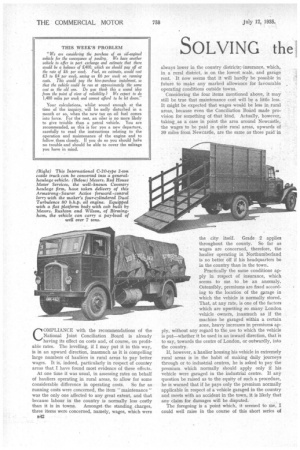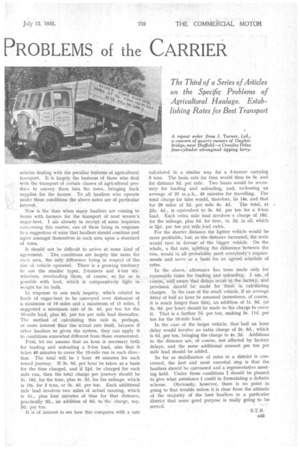SOLVING •the] PROBLEMS of the CARRIER
Page 56

Page 57

If you've noticed an error in this article please click here to report it so we can fix it.
The Third of a Series of Articles on the Specific Problems of Agricultural Haulage. Establishing Rates for Beet Transport
COMPLIANCE with the recommendations of the National Joint Conciliation Board is already having its effect on costs and, of course, on profitable rates. The levelling, if I may put it in this way, is in an upward direction, inasmuch as it is compelling large numbers of hauliers in rural areas to pay better wages. It is, indeed, particularly in respect of country areas that I have found most evidence of these effects.
At one time it was usual, in assessing rates on behalf of hauliers operating in rural areas, to allow for some
considerable difference in operating costs. So far as running costs were concerned, the item " maintenance " was the only one affected to any great extent, and that because labour in the country is normally less costly than it is in towns. Amongst the standing charges, three items were concerned, namely, wages, which were 33-42 always lower in the country districts; insurance, which, in a rural district, is on the lowest, scale, and garage rent. It now seems that it will hardly be possible in future to make any marked allowance for favourable operating conditions outside towns.
Considering the four items mentioned above, it may still be true that maintenance cost will be a little less. It might be expected that wages would be less in rural areas, because even the Conciliation Board made provision for something of that kind. Actually, however, taking_ as a Case in point the area around Newcastle, the wages to be paid in quite rural areas, upwards of 30 miles from Newcastle, are the same as those paid.in the city itself. Grade 2 applies throughout the county. So far as wages are concerned, therefore, the haulier operating in Northumberland is no better off if his headquarters be in the country than in the town..
Practically the same conditions apply in respect of insurance, which seems to me to be an anomaly. Ostensibly, premiums are fixed according to the location of the garage in which the vehicle is normally stored. That, at any rate, is one of the factors which are upsetting so many London vehicle owners, inasmuch as if the machine be garaged within a certain zone, heavy increases in premiums apply, without any regard to the use to which the vehicle is put—whether it be used in an inward direction, that is to say, towards the centre of London, or outwardly, into the country.
If, however, a haulier housing his vehicle in extremely rural areas is in the habit of making daily journeys through or to industrial centres, he is asked to pay the premium which normally should apply only if his vehicle were garaged in the industrial centre. If anY question be raised as to the equity of such a procedure, he is warned that if he pays only the premium normally applicable in respect of a vehicle garaged in the country and meets with an accident in the town, it is likely that any claim for damages will be disputed.
The foregoing is a point which, it seemed to me, I could well raise in the course of this short series of
articles dealing with the peculiar features of agricultural transport. It is largely the business of those who deal with the transport of certain classes of agricultural produce to convey. them into the town, bringing back suppliei for the farmer. To all hauliers who operate Under these conditions the above notes are of particular interest.
Now is the time when many hauliers are coming to terms with farmers for the transport of next season's sugar-beet. I am already in receipt of some inquiries concerning this matter, one of them being in response to a suggestion of mine that hauliers should combine and agree amongst themselves in each area upon a standard of rates.
It should not be difficult to arrive at some kind of agreement. The conditions are largely the same for each area, the only difference being in respect of the. size of vehicle operated. There is a growing tendency to use the smaller types, 2-tonners and 4-ton sixwheelers, overloading them, of course, so. far as is possible with beet, which is comparatively light in. weight for its bulk.
In response to one such inquiry, which related to loads of sugar-beet to be conveyed over distances of a minimum of 10 miles and a maximum of 15 miles, I suggested a minimum rate of 3s. 4d. per ton for the 10-mile lead, plus 3d. per ton per mile lead thereafter. The method of calculating this rate is, perhaps, of more interest than the actual rate itself, because if other hauliers be given the system, they can apply it to conditions somewhat different from those enumerated.
First, let me assume that an hour is necessary both for loading and unloading a 3-ton load, also that it takes 40 minutes to cover the 10-mile run in each direction. The total will be 1 hour 40 minutes for each round journey. If 3s. 8d. per hour be taken as a basis for the time charged, and if 2-0. be charged for each mile run, then the total charge per journey should be 5s. 10d. for the time, plus 4s. 2d. for the mileage, which is 10s. for 3 tons, or 3s. 4d. per ton. Each additional mile lead involves two miles of actual running, which is 5d., plus four minutes of time for that distance, practically 3d., an addition of 8d. to the charge, say, 3c1.. per ton.
It is of interest to see how this compares with a rate
calculated in a. similar way for a 5-tonner carrying 6 tons. The basic rate for time would then be 5s. and for distance 5d. per mile. Two hours would be necessary for loading and unloading, and, reckoning an average of 25 m.p.h., 48 minutes for tn.-Veiling. The total charge for time would, therefore, be 14s. and that for 20 Miles at 5d. per mile 8s. 4d. The total, at 22s. 4d., is equivalent to 3s. 9d. per ton for a 6-ton load. Each extra mile lead involves a charge of 10d. for the mileage, plus 5cf. for time, is. 3d. in all, which is 2id. per ton ,per. mile lead extra.
For the shorter, distance the lighter vehicle would be more profitable, but, as the distance increased, the scale would turn in favour of the bigger vehicle. On the whale, a flat .rate, splitting the• difference between the two, would in all probability meet everybody's requirements and serve as a basis for an agreed schedule of
rates. •
In the above, allowance has been made only for reasonable times for loading and unloading, I am,. of course, well aware that delas occUr at the factory, and provision should be made for these in calculating charges. In the ease of the small vehicle, if an average delay of half an hour be assumed (sometimes, of course, it is much longer than this), an addition, of is. 9d. (at 3s. 6d. per hour) should be made to the charge to cover it. That is a further 7d. per ton, making 3s. lid, per ton for the 10-mile lead.
In the case of the larger vehicle, that 'half an hour delay would involve an extra charge of 2s. 6d., which is 5d. per ton, bringing the charge to 4s. 2d. Additions to the distance are, of course, not affected by factory delays, and the same additional amount per ton per mile lead should be added.
So far as stabilization of rates in a district is concerned, the first and most essential step is that the hauliers should be canvassed and a representative meeting held. Under those conditions I should be pleased to give what assistance I could in formulating a definite scheme. Obviously, however, there is no point in going to that trouble unless it is clear from the attitude of the majority of the beet hauliers in a particular district that some good purpose is really going .to be served.




























































































